RAKU
ca: RAKU
es: RAKU
Click on the title to see more images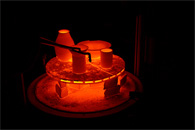 *Raku,*is an oriental technique dating back to the 16th century. It is believed to have originated in Korea but it prospered in Japan and has extended throughout the world, it was originally created for the tea ceremony. The word Raku means “happiness”. It is a method of creating effects with colors and textures either by the use of enamels or simply with smoke, it involves rapid firing and rapid cooling while still red hot from the kiln. The clay used for Raku must be prepared with a high percentage of sand or grog to withstand the rapid and extreme changes of temperature. The clay to be used should be chosen with care to avoid the risk of breakage.
*Raku,*is an oriental technique dating back to the 16th century. It is believed to have originated in Korea but it prospered in Japan and has extended throughout the world, it was originally created for the tea ceremony. The word Raku means “happiness”. It is a method of creating effects with colors and textures either by the use of enamels or simply with smoke, it involves rapid firing and rapid cooling while still red hot from the kiln. The clay used for Raku must be prepared with a high percentage of sand or grog to withstand the rapid and extreme changes of temperature. The clay to be used should be chosen with care to avoid the risk of breakage.
The firing of the enamels is done in gas or wood fired kilns. Raku enamels and colors are fired from 800º to 1000º C with a rapid firingx to reach the right temperature in 15 to 30 minutes, then the kiln is opened and the red hot piece is taken out.
The piece is taken out of the kiln and exposed to the air then put into a metal bucket half full of sand or dry leaves for a short while, just long enough for the reduction and the smoke to penetrate into the piece, transforming the colors and enhancing the crackled enamel effect produced by the heat crash, a common characteristic of this enamel technique. Next it is rapidly cooled down in another bucket full of water and the smoke stuck to the enamel is washed off at the same time.
Besides the finishes achieved with classic enamels, both shiny and crackled, we also have the naked or lost enamel Raku technique, whereby an engobe that does not bond well to the piece is used, causing the enamel to come off at the end of the process leaving only the patterns made by the smoke. The patterns can be left to chance (crackled) or designed by the ceramist.
Another technique is known as the “matt copper” technique. By using an enamel supersaturated with copper, we can achieve a matt finish together with the wide range of colors that copper develops in a reducing atmosphere.
The kiln can be loaded from the top or from the front, although the most recommended type is the one designed so that the body of the kiln is lifted up by pulleys and the fired pieces remain on the floor and so are easy to handle. This procedure produces smoke, so it must be done in the open air. To get the pieces out of the oven you must use long tongs and protect yourself with protective glasses and heatproof gloves.
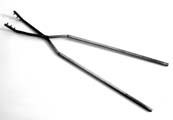 Raku tongs are specially designed with long steel handles and legs. They are used to lift red-hot work out of the kiln and move it to the metal bucket of sand. The length allows you to hold the piece securely, far from your body and from the kiln, which emits very strong smoke and heat when opened.
Raku tongs are specially designed with long steel handles and legs. They are used to lift red-hot work out of the kiln and move it to the metal bucket of sand. The length allows you to hold the piece securely, far from your body and from the kiln, which emits very strong smoke and heat when opened. Red is a strong color with many tones. There is a large selection of reds used in different types of decoration, which are fired at different temperatures. In the past it always had to be fired at a low temperature, between 700 and 800º C. This meant if working with colors fired at a higher temperature, the piece with red had to be fired a second time at a lower heat. In the last years this has changed, now it can be bought to use at different temperatures.
Red is a strong color with many tones. There is a large selection of reds used in different types of decoration, which are fired at different temperatures. In the past it always had to be fired at a low temperature, between 700 and 800º C. This meant if working with colors fired at a higher temperature, the piece with red had to be fired a second time at a lower heat. In the last years this has changed, now it can be bought to use at different temperatures.  The name of a restaurant made in flat relief, shown above, is made in twelve parts that form three sections and each one is decorated differently.
The name of a restaurant made in flat relief, shown above, is made in twelve parts that form three sections and each one is decorated differently.  Repeated tiles are designs on tiles made up to form a repeated pattern and the designs can be of one or more tiles put together to form a continued design.
Repeated tiles are designs on tiles made up to form a repeated pattern and the designs can be of one or more tiles put together to form a continued design. 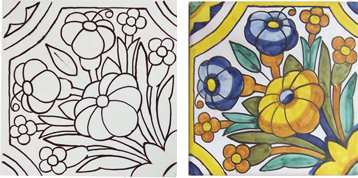 Repeated designs on tiles. Here is explained creating a design for only one tile, it is the same if there are more than one.
Repeated designs on tiles. Here is explained creating a design for only one tile, it is the same if there are more than one.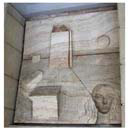 Repoussé, the dictionary explanation is: “A design raised in relief by hammering out on the reverse side.” It is a French word meaning “pushed up”. The word also applies to a design in three dimensions but in reverse, pushed inwards not outwards. When using clay, it can either be built up or dug out so the design is inwards, but with marble the design has to be carved out.
Repoussé, the dictionary explanation is: “A design raised in relief by hammering out on the reverse side.” It is a French word meaning “pushed up”. The word also applies to a design in three dimensions but in reverse, pushed inwards not outwards. When using clay, it can either be built up or dug out so the design is inwards, but with marble the design has to be carved out. 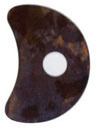 Ribs are ceramic tools made of plastic, wood, metal and rubber and are used to smooth clay while turning with a wheel. They have this name because originally animal bones were used to make them. There are several sizes and two types ridged and flexible.
Ribs are ceramic tools made of plastic, wood, metal and rubber and are used to smooth clay while turning with a wheel. They have this name because originally animal bones were used to make them. There are several sizes and two types ridged and flexible.  Rolling pin is a cooking tool used for rolling out pastry and in ceramics, for rolling out clay. The clay is put between two walls or square poles of the same height. The height of the poles is the height you want your clay to be. Roll over the clay until the rolling pin rests on the walls, it will then be the height required.
Rolling pin is a cooking tool used for rolling out pastry and in ceramics, for rolling out clay. The clay is put between two walls or square poles of the same height. The height of the poles is the height you want your clay to be. Roll over the clay until the rolling pin rests on the walls, it will then be the height required. 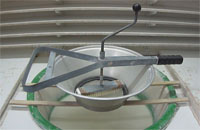 Rotary sieve; made in metal with all its parts dismountable. It has changeable floors of disks with different sized mesh. It has two handles, one overlaps the wall on both sides and at one end is the handle to pick it up with, both are attached with screws to the wall and in the middle there is a hole which the second handle goes through and is attached to the brush. When turned it rotates a brush over the mesh and pushes the substances, liquid or powders through the mesh.
Rotary sieve; made in metal with all its parts dismountable. It has changeable floors of disks with different sized mesh. It has two handles, one overlaps the wall on both sides and at one end is the handle to pick it up with, both are attached with screws to the wall and in the middle there is a hole which the second handle goes through and is attached to the brush. When turned it rotates a brush over the mesh and pushes the substances, liquid or powders through the mesh. 

 Roulette Wheels – Roller Tools – They are known by these two names in English.
Roulette Wheels – Roller Tools – They are known by these two names in English. 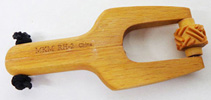 Industrially made. They many different types of roller tools, in shapes, sizes and the materials they are made of. The ones in the following photos are made with hard wood that has been prepared to be durable against dampness. It is in two parts the handle and roller, the rollers are made with different sizes in length, diameter and designs to use with the same handle, the smallest 0.5 cm and the largest is 6,0.cm and each size has a large selection of different stamp designs. The following photos show how to use them.
Industrially made. They many different types of roller tools, in shapes, sizes and the materials they are made of. The ones in the following photos are made with hard wood that has been prepared to be durable against dampness. It is in two parts the handle and roller, the rollers are made with different sizes in length, diameter and designs to use with the same handle, the smallest 0.5 cm and the largest is 6,0.cm and each size has a large selection of different stamp designs. The following photos show how to use them. Ruler is a strip of wood, metal or plastic with straight edges that are usually marked with whole and fractional units of length, inches, centimeters or both and used to draw straight lines and measure lengths. Rulers are made in different lengths, from ten centimeters to five meters and in one piece or many pieces hinged together to fold up. The illustrations show three types.
Ruler is a strip of wood, metal or plastic with straight edges that are usually marked with whole and fractional units of length, inches, centimeters or both and used to draw straight lines and measure lengths. Rulers are made in different lengths, from ten centimeters to five meters and in one piece or many pieces hinged together to fold up. The illustrations show three types. 